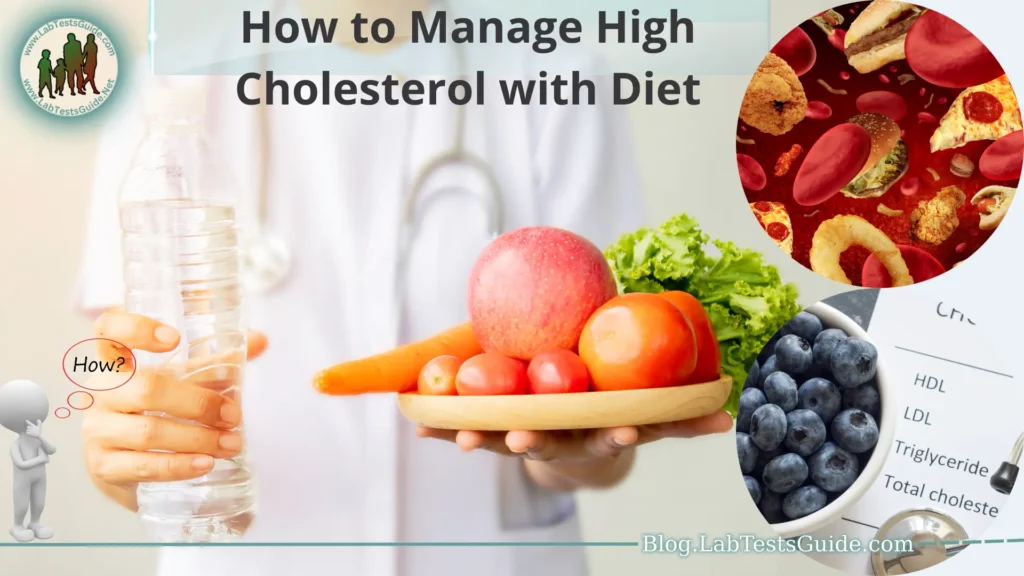High cholesterol is a common health concern that can significantly impact cardiovascular health. Cholesterol is a waxy, fat-like substance found in our blood, and while it is essential for certain bodily functions, having elevated levels of cholesterol, especially LDL (low-density lipoprotein) cholesterol, can increase the risk of heart disease and other cardiovascular problems. Fortunately, diet plays a crucial role in managing cholesterol levels, and by making smart and informed dietary choices, individuals can effectively lower their cholesterol and improve their overall heart health. In this guide, we will explore various dietary strategies and lifestyle modifications that can help you manage high cholesterol levels.

You will learn about the different types of cholesterol, how to interpret cholesterol test results, and set realistic cholesterol goals. Additionally, we will delve into the foods to limit or avoid, such as saturated and trans fats, as well as the importance of reducing processed and high-sugar foods. On the flip side, we will also highlight heart-healthy foods that should be incorporated into your diet, like high-fiber foods, omega-3 fatty acids, and plant sterols. Furthermore, we will discuss popular heart-healthy diets, meal planning tips, and even provide guidance on making healthy choices while dining out. By the end of this guide, you will have a comprehensive understanding of how to use dietary interventions to effectively manage high cholesterol and pave the way for a healthier heart and a better quality of life.
What Is High Cholesterol?
- Cholesterol Definition: Cholesterol is a type of lipid (fat) that is naturally produced in the liver and also obtained through certain foods in our diet. It is a crucial component of cell membranes and plays a role in various bodily functions.
- Cholesterol Transport: Cholesterol travels through the bloodstream attached to lipoproteins. There are two main types of lipoproteins: low-density lipoprotein (LDL) and high-density lipoprotein (HDL).
- LDL Cholesterol: Often referred to as “bad cholesterol,” LDL carries cholesterol from the liver to the cells. However, when there is an excess of LDL cholesterol in the blood, it can lead to the buildup of plaque in the arteries, increasing the risk of atherosclerosis and heart disease.
- HDL Cholesterol: Known as “good cholesterol,” HDL helps remove excess cholesterol from the blood vessels and transport it back to the liver for excretion, reducing the risk of heart disease.
- Cholesterol Levels: Cholesterol levels are measured in milligrams per deciliter (mg/dL) of blood. The optimal levels are generally considered to be.
- Total Cholesterol: Less than 200 mg/dL
- LDL Cholesterol: Less than 100 mg/dL (for those at higher risk, less than 70 mg/dL)
- HDL Cholesterol: 60 mg/dL or higher (considered protective)
- Hypercholesterolemia: High cholesterol, also known as hypercholesterolemia, is a condition where there is an excessive amount of cholesterol in the blood, particularly LDL cholesterol.
- Risk Factors: Several factors can contribute to high cholesterol levels, including an unhealthy diet high in saturated and trans fats, lack of physical activity, smoking, obesity, and certain genetic factors.
- Importance of Management: Managing high cholesterol is vital to prevent or reduce the risk of heart disease, heart attacks, strokes, and other cardiovascular complications.
- Diagnosis: High cholesterol is diagnosed through a blood test called a lipid profile, which measures total cholesterol, LDL cholesterol, HDL cholesterol, and triglyceride levels.
- Treatment: Lifestyle modifications, such as adopting a heart-healthy diet, regular exercise, and weight management, are often the first line of treatment for managing high cholesterol. In some cases, medication may be prescribed by a healthcare professional to further lower cholesterol levels.
How to Manage High Cholesterol with Simple Dietary Changes:
Reduce Saturated Fats:
- Limit the intake of foods high in saturated fats, such as fatty cuts of meat, full-fat dairy products, and tropical oils (coconut and palm oil).
- Opt for leaner protein sources like skinless poultry, fish, and legumes.
Avoid Trans Fats:
- Read food labels and avoid products with “partially hydrogenated oils” listed in the ingredients, as they contain trans fats.
- Opt for healthier fats, like olive oil and avocados.
Increase Fiber Intake:
- Choose whole grains like brown rice, quinoa, and whole wheat over refined grains.
- Include more fruits, vegetables, nuts, and seeds in your diet for a fiber boost.
Focus on Heart-Healthy Fats:
- Incorporate foods rich in omega-3 fatty acids, such as fatty fish (salmon, mackerel, and trout) and chia seeds.
- Snack on nuts (almonds, walnuts) and seeds (flaxseeds) for heart-healthy fats.
Consume More Plant Sterols and Stanols:
- These natural compounds help block cholesterol absorption in the intestines.
- Look for fortified foods like certain margarines, spreads, and orange juice that contain added plant sterols or stanols.
- Eat More Fruits and Vegetables: Aim for a variety of colorful fruits and vegetables, as they are rich in antioxidants and fiber, which support heart health.
- Choose Low-Fat Dairy Products: Opt for low-fat or fat-free versions of dairy products like milk, yogurt, and cheese.
- Limit Processed and Sugary Foods: Reduce the intake of processed foods, fast food, and sugary snacks, as they often contain unhealthy fats and added sugars.
- Control Portion Sizes: Be mindful of portion sizes to avoid overeating, which can lead to weight gain and increased cholesterol levels.
- Cook Healthier: Use healthier cooking methods such as baking, grilling, steaming, or sautéing with minimal oil.
- Limit the use of butter and high-fat sauces.
Know Your Cholesterol Levels:
Cholesterol Testing:
- Regular cholesterol testing is essential to understand your cholesterol levels and overall cardiovascular health.
- A simple blood test called a lipid profile is used to measure cholesterol levels, including total cholesterol, LDL cholesterol, HDL cholesterol, and triglycerides.
Ideal Cholesterol Levels:
- Total Cholesterol: Less than 200 mg/dL is considered desirable.
- LDL Cholesterol: Ideally, less than 100 mg/dL. However, for individuals with a higher risk of heart disease, a target of less than 70 mg/dL may be recommended.
- HDL Cholesterol: A higher level is better for HDL cholesterol. For men, 40 mg/dL or higher is considered desirable, while for women, 50 mg/dL or higher is recommended.
- Triglycerides: Less than 150 mg/dL is considered normal.
Interpreting Cholesterol Numbers:
- High LDL Cholesterol: Elevated LDL cholesterol levels are associated with an increased risk of atherosclerosis, heart disease, and stroke.
- Low HDL Cholesterol: Low levels of HDL cholesterol are linked to a higher risk of heart disease.
- High Triglycerides: Elevated triglyceride levels may also be associated with an increased risk of heart disease.
Setting Cholesterol Goals:
- Work with your healthcare provider to determine personalized cholesterol goals based on your age, risk factors, and overall health.
- Depending on your risk profile, your doctor may recommend different targets for LDL cholesterol levels.
Frequency of Testing:
- For healthy individuals with normal cholesterol levels, testing is recommended every 4 to 6 years.
- If you have elevated cholesterol levels or other risk factors, more frequent testing may be necessary.
Monitoring Progress:
- Regular cholesterol testing allows you to monitor the effectiveness of lifestyle changes or medications in managing your cholesterol levels.
- It is essential to follow up with your healthcare provider and discuss any changes in your cholesterol numbers.
Risk Factors:
- Various factors can influence cholesterol levels, including diet, physical activity, genetics, age, gender, and overall health.
- Understanding these risk factors can help in developing a comprehensive approach to managing cholesterol.
- Importance of Early Detection: Detecting high cholesterol levels early can lead to timely interventions to reduce the risk of heart disease and related complications.
Personalized Recommendations:
- Your healthcare provider can provide personalized recommendations based on your cholesterol levels and risk factors.
- Lifestyle changes, medication, or a combination of both may be suggested to help you achieve your cholesterol goals.
Foods to Limit or Avoid:
Saturated Fats:
- Red Meat: Limit consumption of fatty cuts of beef, pork, and lamb.
- Poultry Skin: Remove the skin from chicken and turkey before cooking.
- Full-Fat Dairy: Reduce intake of whole milk, cream, butter, and full-fat cheese.
Trans Fats:
- Processed Foods: Avoid snacks like cookies, crackers, and pastries made with partially hydrogenated oils.
- Fried Foods: Cut back on deep-fried foods like French fries and fried chicken.
Dietary Cholesterol:
- Organ Meats: Limit the consumption of liver and other organ meats, as they are high in cholesterol.
- Shellfish: Although generally low in saturated fat, some shellfish can be high in cholesterol, so consume them in moderation.
Processed and High-Sugar Foods:
- Sugary Snacks: Reduce the intake of candies, sugary cereals, and sweet desserts.
- Sugary Beverages: Avoid sugary sodas, energy drinks, and sweetened fruit juices.
High-Sodium Foods:
- Salty Snacks: Limit the consumption of chips, salted nuts, and pretzels.
- Processed Meats: Cut back on sausages, bacon, and deli meats, as they often contain high levels of sodium.
Fast Food and Commercial Baked Goods:
- Fast-Food Meals: These are often high in unhealthy fats, sodium, and empty calories.
- Commercial Baked Goods: Many commercially baked items like cakes, pastries, and doughnuts are loaded with unhealthy fats and added sugars.
- Palm and Coconut Oils: These tropical oils are high in saturated fats and can raise LDL cholesterol levels.
- Excessive Alcohol: While moderate alcohol consumption may have some heart benefits, excessive alcohol intake can lead to increased triglyceride levels and contribute to high cholesterol.
- Limit Excess Calorie Intake: Consuming more calories than your body needs can lead to weight gain, which may affect cholesterol levels.
- Condiments and Sauces High in Saturated Fats: Some sauces, like creamy salad dressings and certain gravies, can be high in saturated fats and should be used sparingly.
Heart-Healthy Foods to Incorporate:
- Fatty Fish: Salmon, mackerel, trout, and sardines are rich in omega-3 fatty acids, which can help reduce inflammation and lower triglyceride levels.
- Nuts and Seeds: Almonds, walnuts, chia seeds, flaxseeds, and hemp seeds are excellent sources of heart-healthy fats, fiber, and antioxidants.
Fruits and Berries:
- Berries (blueberries, strawberries, raspberries) are packed with antioxidants that support heart health.
- Apples, oranges, and other fruits provide fiber, vitamins, and minerals that contribute to overall cardiovascular well-being.
Vegetables:
- Leafy greens (spinach, kale, collard greens) are rich in vitamins and antioxidants, helping to lower inflammation.
- Broccoli, cauliflower, and Brussels sprouts contain heart-protective nutrients.
- Whole Grains: Oats, quinoa, brown rice, whole wheat, and barley are high in soluble fiber, which helps reduce LDL cholesterol levels.
- Legumes: Beans, lentils, and chickpeas are rich in protein and fiber, promoting heart health and helping manage cholesterol levels.
- Avocado: Avocados are a great source of monounsaturated fats, which can improve cholesterol levels.
- Olive Oil: Olive oil, especially extra virgin olive oil, is a healthy source of monounsaturated fats and antioxidants.
- Green Tea: Green tea contains compounds that may improve cholesterol levels and have other heart-protective benefits.
- Dark Chocolate: Dark chocolate with a high cocoa content (70% or more) has been linked to improved heart health due to its antioxidant properties.
- Flaxseed Oil: Flaxseed oil is rich in alpha-linolenic acid (ALA), an omega-3 fatty acid that can benefit heart health.
- Tomatoes: Tomatoes are rich in lycopene, an antioxidant that may help lower LDL cholesterol levels.
- Garlic: Garlic has been associated with potential cholesterol-lowering effects and can be a flavorful addition to many dishes.
Adopting a Heart-Healthy Diet:
Emphasize Whole Foods:
- Choose whole, minimally processed foods over highly processed options.
- Base your meals around fruits, vegetables, whole grains, lean proteins, and healthy fats.
Reduce Saturated and Trans Fats:
- Limit the intake of foods high in saturated and trans fats, such as red meat, full-fat dairy, and fried foods.
- Opt for healthier fats found in nuts, seeds, avocados, and olive oil.
- Include Omega-3 Fatty Acids: Incorporate fatty fish (salmon, mackerel, trout) or plant-based sources (flaxseeds, chia seeds) rich in omega-3s for heart health.
- Add High-Fiber Foods: Include a variety of fiber-rich foods like whole grains, legumes, fruits, and vegetables to help manage cholesterol levels.
- Use Herbs and Spices: Substitute salt with herbs and spices to season your meals, reducing sodium intake.
Limit Added Sugars and Refined Carbohydrates:
- Minimize consumption of sugary snacks, sweets, and sugary beverages.
- Choose whole grains over refined grains to help stabilize blood sugar levels.
- Choose Lean Proteins: Opt for lean cuts of meat, skinless poultry, and plant-based proteins like beans and lentils.
- Practice Portion Control: Be mindful of portion sizes to prevent overeating and maintain a healthy weight.
- Stay Hydrated with Water: Drink plenty of water throughout the day and avoid sugary drinks.
Enjoy Balanced Meals:
- Create balanced meals that include a variety of nutrients and food groups.
- Aim to have a colorful plate with different fruits and vegetables.
- Cook at Home: Prepare homemade meals to have better control over ingredients and portion sizes.
- Read Food Labels: Check food labels for saturated fats, trans fats, added sugars, and sodium content.
Meal Planning and Preparation:
Set Realistic Goals:
- Define your dietary goals based on your health needs, such as managing cholesterol levels or achieving a healthy weight.
- Establish achievable targets for incorporating heart-healthy foods into your meals.
- Plan Ahead: Take time to plan your meals for the week in advance. This helps you make healthier choices and reduces the temptation to opt for unhealthy options when you’re hungry and in a rush.
Create Balanced Meals:
- Ensure that your meals include a mix of lean proteins, whole grains, healthy fats, and a variety of fruits and vegetables.
- Aim for a colorful plate to ensure you get a range of nutrients.
- Include Heart-Healthy Ingredients: Incorporate heart-healthy foods like fatty fish, nuts, seeds, legumes, and whole grains into your meal plans.
- Batch Cooking: Cook larger quantities of healthy meals and store them in portion-sized containers for later use. This can save time and help you avoid unhealthy takeout options.
- Practice Portion Control: Be mindful of portion sizes to avoid overeating, as even healthy foods can contribute to weight gain if consumed in excess.
- Cook at Home: Home-cooked meals allow you to control the ingredients and cooking methods, making it easier to follow a heart-healthy diet.
- Experiment with Cooking Techniques: Explore healthier cooking methods like baking, grilling, steaming, or sautéing with minimal oil, instead of frying.
- Limit Salt and Sodium: Use herbs, spices, and other seasonings to add flavor to your meals instead of relying on excessive salt.
- Prep Fruits and Vegetables: Wash, chop, and prepare fruits and vegetables in advance to make them easily accessible for quick snacks or meal ingredients.
- Pack Healthy Snacks: Keep a supply of heart-healthy snacks like nuts, seeds, cut-up fruits, or veggie sticks ready to grab when you need a quick bite.
- Read Food Labels: When buying packaged foods, read the labels to identify hidden sources of unhealthy fats, added sugars, and excessive sodium.
Tips for Dining Out:
- Research Ahead of Time: Look up the restaurant’s menu online before going to identify healthier options and make informed choices.
- Choose Restaurants with Healthy Options: Opt for restaurants that offer a variety of heart-healthy dishes and fresh ingredients.
- Control Portion Sizes: Restaurants often serve larger portions than necessary. Consider sharing a meal or asking for a half-portion to avoid overeating.
- Avoid All-You-Can-Eat Buffets: Buffets can lead to overeating and excessive consumption of unhealthy foods. Choose a restaurant with healthier a la carte options instead.
- Start with a Salad or Vegetable-Based Appetizer: Having a salad or vegetable-based appetizer can help you feel satisfied and reduce the likelihood of overeating calorie-dense main courses.
- Ask for Modifications: Don’t hesitate to ask for healthy substitutions or adjustments, such as dressing on the side, grilled instead of fried, or whole-grain options.
- Be Mindful of Sauces and Dressings: Many sauces and dressings can be high in unhealthy fats and added sugars. Request them on the side and use sparingly.
- Watch Out for Hidden Ingredients: Be aware of hidden sources of unhealthy fats, such as butter and excessive oil, that restaurants may use in their dishes.
- Limit Alcoholic Beverages: Alcoholic drinks can be high in calories and can negatively impact heart health. Opt for water, unsweetened tea, or other non-alcoholic beverages.
- Practice Portion Control with Desserts: If you want to enjoy dessert, consider sharing it with others or choosing a smaller portion.
Monitoring Progress and Seeking Professional Help:
Regular Check-ups and Follow-ups:
- Schedule regular check-ups with your healthcare provider to monitor your cholesterol levels and overall cardiovascular health.
- Follow your doctor’s recommendations for follow-up visits and tests.
Track Your Diet and Exercise:
- Keep a food diary to track your daily food intake, making it easier to identify patterns and areas for improvement.
- Monitor your physical activity to ensure you are staying active as part of your heart-healthy lifestyle.
Check Cholesterol Levels:
- Regularly monitor your cholesterol levels through blood tests as advised by your healthcare provider.
- Keep track of your progress in achieving your cholesterol goals.
- Review Medication, if Prescribed: If your healthcare provider prescribes cholesterol-lowering medication, take it as directed and follow up with any concerns or side effects.
- Seek Support from a Registered Dietitian: Consulting with a registered dietitian can help you create personalized meal plans and address specific dietary needs or challenges.
- Collaborate with Your Healthcare Team: Share any changes in your health or lifestyle with your healthcare team to receive guidance and appropriate adjustments to your plan.
- Set Realistic Goals and Celebrate Progress: Establish achievable short-term and long-term goals for managing your cholesterol levels and celebrate each milestone achieved.
- Make Necessary Adjustments: If you encounter challenges in managing your cholesterol, be willing to make adjustments to your diet and lifestyle plan as needed.
- Educate Yourself: Stay informed about heart-healthy practices and the latest research on cholesterol management to make informed decisions.
- Be Patient and Persistent: Improving cholesterol levels and overall heart health takes time and dedication. Be patient with yourself and stay persistent in your efforts.
FAQs:
What is high cholesterol, and why is it a concern for heart health?
High cholesterol refers to elevated levels of cholesterol, particularly LDL cholesterol, in the blood. High LDL cholesterol can lead to the formation of plaque in the arteries, increasing the risk of heart disease, heart attacks, and strokes.
Can I manage high cholesterol with diet alone, or do I need medication?
In many cases, lifestyle changes, including adopting a heart-healthy diet, can effectively manage high cholesterol. However, some individuals may require cholesterol-lowering medications as well. It is essential to work with your healthcare provider to determine the best approach for your specific situation.
What are some heart-healthy dietary patterns I can follow to manage cholesterol?
Heart-healthy dietary patterns include the Mediterranean diet, DASH (Dietary Approaches to Stop Hypertension) diet, and TLC (Therapeutic Lifestyle Changes) diet. These diets emphasize whole foods, fruits, vegetables, lean proteins, and healthy fats while limiting saturated and trans fats.
Are there specific foods I should avoid to lower my cholesterol?
Yes, you should limit or avoid foods high in saturated and trans fats, such as fatty meats, full-fat dairy, and processed snacks. Additionally, reducing your intake of dietary cholesterol from sources like organ meats and shellfish can be beneficial.
What are some heart-healthy fats I can include in my diet?
Heart-healthy fats include monounsaturated fats found in olive oil and avocados, as well as omega-3 fatty acids found in fatty fish (salmon, mackerel, trout) and plant sources like flaxseeds and chia seeds.
How can I incorporate more fruits and vegetables into my diet?
Aim to fill half your plate with fruits and vegetables at meals. Snack on fresh or cut-up fruits, and add vegetables to soups, salads, stir-fries, and pasta dishes.
Can I still eat out at restaurants while managing my cholesterol?
Yes, you can dine out while managing cholesterol. Research restaurant menus ahead of time, choose restaurants with healthier options, and make mindful choices by avoiding excessive unhealthy fats and portions.
How long does it take to see improvements in cholesterol levels with diet changes?
The time it takes to see improvements in cholesterol levels can vary from person to person. Generally, significant changes may be observed within a few weeks to a few months of adopting a heart-healthy diet and lifestyle.
Should I avoid all fats in my diet to manage cholesterol?
No, not all fats are harmful. Healthy fats are essential for overall health and can help improve cholesterol levels. Focus on incorporating sources of monounsaturated fats and omega-3 fatty acids into your diet.
How often should I get my cholesterol levels checked?
The frequency of cholesterol testing depends on your individual health and risk factors. For healthy individuals, cholesterol levels may be checked every 4 to 6 years. However, if you have high cholesterol or other risk factors, more frequent testing may be necessary.
Conclusion:
In conclusion, managing high cholesterol through a heart-healthy diet is a vital component of overall cardiovascular health. By making simple dietary changes, such as reducing saturated and trans fats, incorporating heart-healthy foods like fatty fish, nuts, and vegetables, and practicing portion control, individuals can effectively lower their cholesterol levels and reduce the risk of heart disease. Additionally, staying mindful of food choices while dining out, monitoring progress regularly, and seeking professional guidance when needed contribute to long-term success in managing high cholesterol. Remember, adopting a heart-healthy lifestyle is a lifelong commitment, and with dedication and support, individuals can achieve better heart health and improve their overall well-being.







One Comment